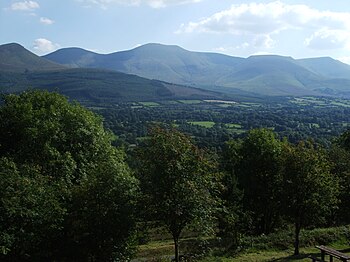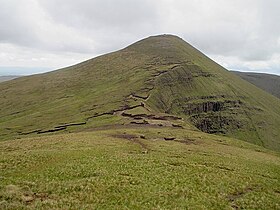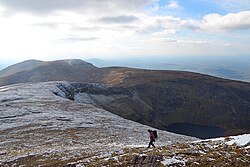Galtee Mountains

The Galtee Mountains (also spelled 'Galty Mountains') stand in the west of the Counties of Cork and Limerick.
The highest of the range is Galtymore, which climbs to 3,011 feet, making it a Furth Munro (one of only 13 in Ireland) and with its summit marking the county border it is also the county top of both Cork and Limerick.
The Galtee Mountains are of sandstone and shale, with 24 peaks above 1,200 feet. The range runs which runs east-west for 18 miles between the two counties. A 5–6 hour Circuit of Glencushnabinnia walk runs over the mountains, and a 10–hour east-to-west crossing of the entire range, called the Galtee Crossing, is climbed annually in the Galtee Challenge.
The range was historically named Sliabh gCrot (the hump mountains), anglicised as "Slievegrot";[1] or Crotta Cliach (the humps of Cliú), after the territory of Cliú.[2][3]
Galtymore and its deep corrie lakes are associated with various Irish folklore tales regarding Saint Patrick and serpents.
Geography
- Location map: 52°21’58"N, 8°10’45"W

The climbing guidebook writer Paddy Dillion said of the range: "the lofty Galty Mountains have forested flanks; and there is much heather, bogs, and steep slopes, but the effort is worth it and Galtymore is a splendid viewpoint".[4]
The Galty (or "Galtee") Mountains are a broadly straight grass-covered range of mountains stretching about 20 miles east-west with a nine-mile central ridge section, stretching from Greenane (2,628 feet) in the east, to 'Temple Hill (2,569 feet) in the west. This central ridge section includes the highest peaks: Galtymore (3,011 feet), Lyracappul (2,707 feet), Carrignabinnia (2,700 feet), and Slievecushnabinnia (2,543 feet). Many of the peaks of the central section have a moderate topographical prominence, which means that the central ridge maintains a reasonably sustained height; an attractive feature for hill walkers.[4]
Of the 24 peaks of the Galty range with a height above 1,200 feet, 13 exceed 2,000 feet. The Galtys are described as Ireland's highest "inland" range.
Galtymore and Galtybeg stand near the middle of the range and their north faces show evidence of glacial erosion with a number of deep corries, most of which are now occupied by loughs. Between Galtymore and Galtybeg lies Lough Diheen, while Lough Curra lies between Galtymore and Slievecushnabinnia.[4]
The peaks
Galty has 24 peaks with a height above 1,000 feet.[5]
| Rank | Name | Irish (if different) | Translation | Height (ft) | Prom. (ft) |
Height (m) | Prom. (m) |
Map | OSI Grid Ref |
|---|---|---|---|---|---|---|---|---|---|
| 1 | Galtymore | Cnoc Mór na nGaibhlte | big hill of the Galtys | 3,011 feet | 2,946 ft | 918 m | 898 m | 74 | R878238 |
| 2 | Lyracappul | Ladhar an Chapaill | fork/confluence of the horse | 2,708 feet | 328 ft | 825 m | 100 m | 74 | R845232 |
| 3 | Carrignabinnia | Carraig na Binne | rock of the peak | 2,700 feet | 88 ft | 823 m | 27 m | 74 | R850237 |
| 4 | Greenane | An Grianán | sunny spot | 2,629 feet | 515 ft | 801 m | 157 m | 74 | R925239 |
| 5 | Galtybeg | — | — | 2,622 feet | 263 ft | 799 m | 80 m | 74 | R890241 |
| 6 | Greenane West | — | — | 787 feet | 39 ft | 2,582 m | 129 m | 74 | R910239 |
| 7 | Temple Hill | Cnoc an Teampaill | hill of the church | 2,569 feet | 617 feet | 783 m | 188 m | 74 | R833218 |
| 8 | Slievecushnabinnia | Sliabh Chois na Binne | mountain beside the peak | 2,542 feet | 92 ft | 775 m | 28 m | 74 | R858240 |
| 9 | Knockaterriff | Cnoc an Tairbh | hill of the bull | 2,269 feet | 168 ft | 692 m | 51 m | 74 | R848216 |
| 10 | Knockaterriff Beg | Cnoc an Tairbh Beag | hill of the little bull | 2,229 feet | 91 ft | 679 m | 28 m | 74 | R844222 |
| 11 | Cush | Cois | side/flank | 2,104 feet | 578 ft | 641 m | 176 m | 74 | R894262 |
| 12 | Monabrack | Móin Bhreac | speckled moor | 2,067 feet | 308 ft | 630 m | 94 m | 74 | R859219 |
| 13 | Laghtshanaquilla | Leacht Sheanchoille | burial monument of the old wood | 2,065 feet | 118 ft | 629 m | 36 m | 74 | R951250 |
| 14 | Knockeenatoung | Cnoicín na Teanga | hill of the tongue | 1,973 feet | 218 ft | 601 m | 66 m | 74 | R895219 |
| 15 | Lough Curra Mt | — | — | 1,970 feet | 75 ft | 600 m | 23 m | 74 | R869242 |
| 16 | Laghtshanaquilla NE Top | — | — | 1,962 feet | 62 ft | 598 m | 19 m | 74 | R957256 |
| 17 | Knockastakeen | Cnoc an Stáicín | hill of the little stack | 1,913 feet | 256 ft | 583 m | 78 m | 74 | R915258 |
| 18 | Sturrakeen | An Starraicín | "the pointed peak" or "the steeple" | 1,777 feet | 151 ft | 542 m | 46 m | 74 | R973253 |
| 19 | Benard | An Bhinn Ard | the high peak | 1,573 feet | 277 ft | 480 m | 85 m | 74 | R821199 |
| 20 | Slieveanard NE Top | — | — | 1,471 feet | 210 ft | 449 m | 64 m | 74 | S005264 |
| 21 | Seefin | Suí Finn | Fionn's seat | 1,465 feet | 136 ft | 447 m | 42 m | 74 | R891197 |
| 22 | Seefin N Top | — | — | 1,457 feet | 128 ft | 444 m | 39 m | 74 | R888206 |
| 23 | Slieveanard | Sliabh an Aird | mountain of the height | 1,436 feet | 108 ft | 438 m | 33 m | 74 | R992258 |
| 24 | Slievenamuck | Sliabh Muice | mountain of the pig | 1,211 feet | 768 ft | 369 m | 234 m | 66 | R842306 |
Geology
The geology of the Galty Mountains is described as being Old Red Sandstone, from the Devonian period, and Silurian shales.[6] Old Red Sandstone is also common in MacGillycuddy's Reeks in County Kerry, and as well as having a purple–reddish colour, is also devoid of fossils.
The southern smooth slopes of the Galty range give way to a steep northern face, pocked with deep corries and their accompanying moraine lakes.[6] The long central ridge of the Galtys, which runs for about nine miles in an east-west direction, was too high to be overridden by the inland ice-sheets, and although it resulted in the creation of small corrie glaciers, its summits are capped by tors formed from conglomerate rock (known as the Slievenamuck Conglomerate Formation).[6]
Hill walking

The most straightforward route to the summit of Galtymore is from the south by the 5½ mile, 3–4 hour Black Road Route, which starts at the end of the Black Road car park (R893204) (accessed from the R639 road near the village of Skeheenarinky), and summits Galtybeg (2,621 feet), before the main summit of Galtymore. It then retraces its route back to the Black Road car park.[7][8]

The 7½-mile, 5–6 hour Circuit of Glencushnabinnia, follows a loop around Galtymore's deep northern corries at Lough Curra and Lough Dihneen. It is described as the "connoisseur's route".[7][9] It starts at the forest car park (R875278) near the Clydagh Bridge in the north, and climbs Cush (2,103 feet), Galtybeg (2,556 feet), Galtymore and Slievecushnabinnia (2543 feet), before returning to the start; or it can be done anti–clockwise.[7][9][10]

The annual Galtee Challenge organised by the Galtee Walking Club is the full 19½-mile east-to-west crossing of the range, taking over 10 hours . This, also called the Galtee Crossing, and takes in all major peaks of the Galty Mountains. The challenge normally starts in Cahir in the east, and finishes in Anglesboro Village, in the west.[11] Despite the distance, longer than the MacGillycuddy's Reeks Ridge Walk, the 10–hour estimate is reasonable as the variation in elevation is moderate.[11]
Folklore

The mountains appear in Irish folk tales, and the deep corrie lakes of the Galtys were believed to be enchanted.[12][13] In early Irish literature, the mountains are called [Sliab] Crotta Cliach (the [mountain] humps of Cliú), which was the name of the surrounding territory. As ‘’Lang|ga|crotta’’ can also mean a Celtic harp, the name was interpreted as "mountains of Cliach's harps", and there is a tale of a legendary harper called Cliach playing his harps in the mountains to woo an otherworldly woman who lived in the summit cairn on Slievenamon. After failing, he played his two harps together, and the hill burst open and formed a lake.[12] This lake is Lough Muskry, which is named after the Múscraige people that lived in the south of Ireland.[13]
Lake Muskry was formerly known as Loch Béal Séad (lake of the jewel mouth) and also as Loch Béal Dracon (lake of the dragon's mouth). The oldest mention of the name is in the tale entitled Aislinge Óenguso (The Dream of Aengus) which dates from c.750 AD.[14] This states: Mac Og went to Loch Bél Draccon when he saw the 150 white birds at the loch with their silvery chains and golden caps around their heads. The next oldest mention is in the Dindsenchas, composed c.1000. The Metrical Dindsenchas of Crotta Cliach states: At the spot where he died of terror, Cliach sang sweet melody; there seized him there suddenly, not unprotected, the loathly dragon that dwells in this place - Loch Bel Dragon.[15] The Rennes Dindsenchas also relates a further tale of Saint Fursey drowning the dragon in the lake.[16] [17] There is a folk tale of a serpent that was killing livestock on the Galty Mountains being banished by Saint Patrick and confined to Lake Muskry.[12] According to the tale, Saint Patrick chained the serpent under the lake and promised to release the creature on Lá an Luan (the Day of Judgement), which the serpent mistook as An Luain (Monday or Easter Monday). The serpent comes up each Easter Monday and asks "Is it the Monday morning yet Patrick?" and Patrick says "No", and the serpent goes down again for another year.[12][18] The same legend is also associated with Lough Dihneen, below Galtybeg.[12][13] The belief in the serpent under Lough Dihneen was held so strongly that a Captain Dawson, a local landlord, attempted to drain Lough Dihneen in the 1830s to kill the serpent.
Folk tales attribute the banishing of the serpent by Saint Patrick with the subsequent richness of farming in the area.[19] In addition to local folklore, Lake Muskry also features in Irish mythological tales.
Outside links
| ("Wikimedia Commons" has material about Galtee Mountains) |
References
- ↑ Galty Mountains: Placenames Database of Ireland
- ↑ Hendroff, Adrian (2010). From High Places: A Journey Through Ireland's Great Mountains. The History Press Ireland. p. 150. ISBN 978-1845889890.
- ↑ Rynne, Colin; Buttimer, Neil; Guerin, Helen (2000). The Heritage of Ireland. Collins Press. p. 146. ISBN 978-1898256151.
- ↑ 4.0 4.1 4.2 Dillion, Paddy (1993). The Mountains of Ireland: A Guide to Walking the Summits. Cicerone. ISBN 978-1852841102.
- ↑ MountainViews.ie: Galtymore
- ↑ 6.0 6.1 6.2 "Galtee Mountains cSAC (Special Area of Conservation)". July 2005. p. 12. https://www.npws.ie/sites/default/files/publications/pdf/CP000646.pdf. "Physical Features"
- ↑ 7.0 7.1 7.2 O'Dwyer, John G. (2018). The Comeragh, Galtee, Knockmealdown & Slieve Bloom Mountains: A Walking Guide. Collins Press. ISBN 978-1848893474.
- ↑ O'Dwyer, John G. (29 July 2014). "Go Walk: The Galtees, Co Tipperary". Irish Times. https://www.irishtimes.com/life-and-style/travel/go-walk-the-galtees-co-tipperary-1.1740180.
- ↑ 9.0 9.1 Fairbairn, Helen (2014). Ireland's Best Walks: A Walking Guide. Collins Press. ISBN 978-1848892118. "Route 52: Galtymore"
- ↑ Mills, Russ (20 August 2018). "The Galtymore Cushnabinnia Horseshoe". https://mountaintrails.ie/featured-hike-galtymore-and-the-cushnabinnia-horseshoe/.
- ↑ 11.0 11.1 "2018 Galtee Challenge". June 2018. https://www.galteewalkingclub.ie/challenge.html.
- ↑ 12.0 12.1 12.2 12.3 12.4 "Lough Muskry and St. Patrick". 15 March 2017. http://thetipperaryantiquarian.blogspot.com/2017/03/lough-muskry-st-patrick.html.
- ↑ 13.0 13.1 13.2 Massey, Eithne (2004). Legendary Ireland: A Journey Through Celtic Places and Myths. University of Wisconsin Press. p. 83. ISBN 978-0299198008.
- ↑ [1]
- ↑ "Todd lecture series". Dublin. https://archive.org/details/toddlectureserie10royauoft/page/224/mode/2up.
- ↑ "Revue celtique". Paris. 1870. https://archive.org/details/revueceltique15pari/page/441/mode/1up?view=theater.
- ↑ "Lectures on the manuscript materials of ancient Irish history". Dublin, J. Duffy. 1861. https://archive.org/details/lecturesonmanus00ocur/page/426/mode/2up.
- ↑ Francesca Wild, Lady Jane (1888). "Saint Patrick and the Serpent". Ancient Legends, Mystic Charms, and Superstitions of Ireland [Reprint, 2012]. ISBN 978-1480289833.
- ↑ "St Patrick and the Killer Snake". 2014. https://www.yourirish.com/folklore/st-patrick-killer-snake. "After St Patrick banished the snake he made his way back to the farmers and informed them of the snakes fate. To their relief he told them to go and look after their livestock which will be vast in quantity for years to come. After 7 long years later the snake appeared at the edge of the lake and asked St Patrick "is it time for me be released yet?" to which St Patrick replied "no" and the snake sank back into the lake. Ever since the snake was banished from the area the Galtee Mountains became famous for its dairy farming and its where Ireland's largest food companies, Galtee, was founded."
- Dillion, Paddy (1993). The Mountains of Ireland: A Guide to Walking the Summits. Cicerone. ISBN 978-1852841102.
- Fairbairn, Helen (2014). Ireland's Best Walks: A Walking Guide. Collins Press. ISBN 978-1848892118.
- O'Dwyer, John G. (2018). The Comeragh, Galtee, Knockmealdown & Slieve Bloom Mountains: A Walking Guide. Collins Press. ISBN 978-1848893474.
- Stewart, Simon (2013). A Guide to Ireland's Mountain Summits: The Vandeleur-Lynams & the Arderins. Collins Books. ISBN 978-1-84889-164-7.
